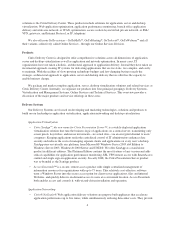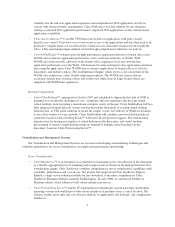Citrix 2007 Annual Report Download - page 20
Download and view the complete annual report
Please find page 20 of the 2007 Citrix annual report below. You can navigate through the pages in the report by either clicking on the pages listed below, or by using the keyword search tool below to find specific information within the annual report.The virtualization products and services we acquired in connection with our acquisition of XenSource are
based on an emerging technology, and therefore the potential market for this line of products and services
remains uncertain.
We acquired XenSource in October 2007 to enter the server and desktop virtualization markets. The
virtualization products and services that we acquired as part of this acquisition are based on an emerging
technology platform the success of which will depend on organizations and customers perceiving technological
and operational benefits and cost savings associated with adopting server and desktop virtualization solutions.
The limited operating history of XenSource prior to our acquisition and the relatively limited extent to which
server and desktop virtualization solutions have been adopted may make it difficult to evaluate this technology’s
impact on our business because the potential market for these products and services remains uncertain. To the
extent that the server and desktop virtualization market develops more slowly or less comprehensively than we
expect, the revenue growth associated with virtualization products and services may be slower than currently
expected, which could adversely affect our business, results of operations and financial condition.
The benefits we anticipate from acquiring XenSource may not be realized.
We acquired XenSource with the expectation that the acquisition will result in various benefits including,
among other things, enhanced revenue and profits, greater market presence and development, and enhancements
to our product portfolio and customer base. We expect that the acquisition will move us into adjacent server and
desktop virtualization markets that will allow us to extend our leadership in the broader Application Delivery
Infrastructure market by adding key enabling technologies that make the end-to-end computing environment
more flexible, dynamic and responsive to business change. We may not realize any of these benefits.
In addition, we may not achieve the anticipated benefits of our acquisition of XenSource as rapidly as, or to
the extent, anticipated by our management and certain financial or industry analysts, and others may not perceive
the same benefits of the acquisition as we do. For example, XenSource’s contribution to our financial results may
not meet the current expectations of our management for a number of reasons, including the integration risks
described above, and could dilute our profits beyond the current expectations of our management. Operations and
costs incurred and potential liabilities assumed in connection with our acquisition of XenSource also could have
an adverse effect on our business, financial condition and operating results. If these risks materialize, our stock
price could be materially adversely affected.
Our business could be adversely impacted by conditions affecting the information technology market.
The demand for our products and services depends substantially upon the general demand for business-
related computer appliances and software, which fluctuates based on numerous factors, including capital
spending levels, the spending levels and growth of our current and prospective customers and general economic
conditions. Fluctuations in the demand for our products and services could have a material adverse effect on our
business, results of operations and financial condition. In the past, adverse economic conditions decreased
demand for our products and negatively impacted our financial results. Future economic projections for the
information technology sector are uncertain. If an unfavorable information technology spending environment
develops, it could negatively impact our business, results of operations and financial condition.
Our long sales cycle for enterprise-wide sales could cause significant variability in our revenue and operating
results for any particular period.
In recent quarters, a growing number of our large and medium-sized customers have decided to implement
our enterprise customer license arrangements on a departmental or enterprise-wide basis. Our long sales cycle for
these large-scale deployments makes it difficult to predict when these sales will occur, and we may not be able to
sustain these sales on a predictable basis.
14
























